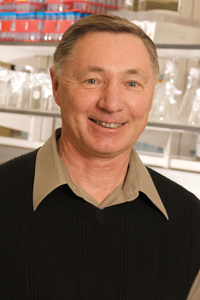 |
Yuri Lyubchenko, Ph.D. |
NOTE: This profile is part of a series highlighting the 23 researchers who were named UNMC Distinguished Scientists or New Investigators for 2008. Each of these researchers will be profiled in UNMC Today leading up to a March 16 ceremony to recognize their achievements.
- Name: Yuri Lyubchenko, Ph.D.
- Title: Professor of pharmaceutical sciences
- Joined UNMC: 2004
- Hometown: Moscow
Describe your research in laymen terms, please.
One of the research projects we are pursuing is to understand how such diseases as Alzheimer’s and Parkinson’s arise and progress.
What led you to pursue this area of research?
This is a relatively new area of my research. I thought about these diseases earlier but did not see an efficient way to approach to this difficult problem. The idea came out rather unexpectedly, as typically happens, and the first experiments showed very promising results.
How do you see your research contributing to science?
All my projects belong to basic science. Translation of our studies to the health related problem is a long-range goal.
Why did you become a scientist?
I had a great physics teacher in high school. He taught me of the importance of physics and recommended that I apply to the Moscow Institute Physics and Technology. The mission of this special university (probably not only for Russia) was to prepare young people to work in science and development of new technologies. After passing the entering exams, I was immersed into the environment where the basic science, primarily physics and mathematics ruled. Biology was a new and exciting area and I started my scientific career in the field of molecular biophysics joining a group of young enthusiastic scientists at the department of radiation biology at the Moscow Institute of Atomic Energy.
What is your hope for the next generation of scientists?
There are breakthroughs in technology leaving us with the feeling that the mysteries of many, if not all, devastating diseases can be solved and appropriate means to fight these diseases will be found in a near future. I would like to note such a breakthrough in optical microscopy as imaging of the process of the protein synthesis in living cells. Armed with the nanotechnology tools, we are able to manipulate with individual molecules and even atoms. However, regardless these technological advances, our understanding of basic biological processes at molecular level remains relatively poor. It is hard to make a progress toward curing the diseases without understanding the mechanism whereby the cellular processes are regulated. This is a challenge for young scientists, and I hope that the future support for the basic biomedical science from federal government will allow current Ph.D. students and younger generations to make it possible.
Beyond grant funding, how do you measure success?
Although the funding is crucial for the research activity, the major excitement comes when an experiment shows the results you waited for a long time, so the idea you conceived works. The acceptance of the finding by your peers, especially the most critical ones, is the next step. It is especially exciting when you receive positive reviews on a submitted paper. Convincing a critical reviewer is another satisfaction and measure of success.
What would you tell a student interested in a research career?
It is really hard to do science as, typically, success comes after numerous failures. But the excitement of your experiment working overturns all frustrations and failures. You will remember such events for years.
Do you have a hero/role model? If so, what do you admire most about this person?
During my life, I have met many very interesting people whom I enjoy. But my admiration remains with Mother Nature. Living things are made so perfectly and all molecular machines operate with enormously high efficiency and accuracy, so despite a continuous and long attack of problems by an army of scientists, we are far from understanding the detailed mechanisms whereby these machines work. Fortunately, there are positive examples. I would like to mention the work on understanding the mechanisms of ATP synthase. This unique machine makes ATP, a fuel for majority of molecular machines and does it very efficiently. The total amount of ATP synthesized by an adult constitutes a half of the body weight, and this ratio grows dramatically during physical exercise. Biochemical studies of Dr. Paul Boyer led him to a conjecture that the enzyme should be a rotational motor and later structural analysis of Professor John Walker supported this ingenious idea. Both were awarded Nobel Prize in chemistry in 1997 for their discovery.
Tell us about your family and hobbies outside of the lab.
We are blessed with two children and four grandchildren. Unfortunately, they are quite far away, so we are unable to see them very often. I like doing home improvement projects when my wife allows me. I like skiing and enjoy the days when snow comes.
List three things few people know about you.
- I was born in Siberia and during my childhood I enjoyed very much cold winter days with a lot of snow;
- During the time when I had to select my master thesis adviser, I had a choice between biophysics and astrophysics; and
- I learned Japanese when I was a graduate student and still now remember how to write “Japan” with characters.